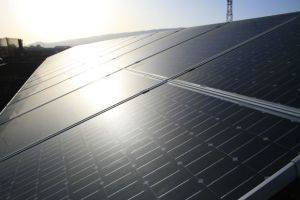PV Plant Monitoring Using a Data Logger

Next Industries Omnialog Data Logger Monitors Several Values
CHESTERLAND OH —
Customer Requirements:
A customer from abroad inquired with CAS DataLoggers about a monitoring and datalogging system for a photovoltaic (PV) energy plant. Their request was not only for a device to measure current and voltage, but also to monitor environmental parameters since the plant is located in a country where serious temperature excursions often happen.
Parameters:
The proposed system measures and logs the plant's generated voltages and current, but also measures:
• Temperature
• Humidity
• Solar Radiation
• Wind Speed
Datalogging:
The Omnialog NI-816 Universal Datalogger is the heart of the proposed PV monitoring system. This rugged data logger is the ideal solution for this application, with 16 universal analog channels to record a variety of values. The Omnialog also has protected inputs and conformal coating on all its internal electronics--this is crucial for this outdoor installation with extreme temperature variations and the possibility of internal moisture formation.
The OMNIAlog NI-816 is a smart datalogger providing an extensive array of features which allow it to be used across a wide variety of applications such as this one. This robust low-power data logger features 8/16 differential universal analog inputs expandable up to 384 channels, 24-bit measurement resolution, and extensive communications capabilities including Ethernet, RS485, RS232 and USB connections.
For flexibility of measurement, the Omnialog can record mV, mA, and mV/V, and the logger is also equipped with an Internal Temperature and Humidity Sensor with a measurement accuracy of 0.01%.
The Omnialog also has 2GB of internal non-volatile data memory and an embedded web server, together with the ability to operate for months in standalone mode on its small sealed lead-acid battery.
Current measurements:
Current transducers (type NI-T201DC) are installed on the electrical cables and connected to the datalogger on a 4-20mA interface to perform this fundamental measurement. The most recent reading is shown on the logger's built-in display.
Similar to a normal TA, these transducers can measure DC currents up to 100A as a galvanic isolated device. The transducers are interfaced to the datalogger on 4-20 mA connections.
Voltage measurements:
In order to measure voltage in a safe and reliable way, we have suggested the NI-Z204 module which can measure voltage values at high precision. These sensors can also have a current-loop interface, but in this case we have decided to configure outputs as 0--10V, with direct connection to the data logger inputs.
Temperature Humidity measurement:
The datalogger itself monitors both temperature and humidity using its internal sensor.
Solar radiation:
A device called a 'solarimeter,' a type of pyranometer, is commonly used to measure solar radiation. This sensor will continuously transmit the level of solar irradiance to the Omnialog data logger.
The NI-DW6450 solarimeter is perfectly suited for this application at a moderate cost. It is based on a silicon cell sensor, which the best solar radiation measurement technology for the photovoltaic industry. The instrument output is a 0-3V voltage level that we have connected to one of the datalogger's analog inputs.
The OMNIAlog data logger will automatically transform and log the voltage values in W/m2.
Wind speed measurement:
An anemometer is required to measure the wind speed, a device normally used in weather stations. The simple, classical wind-cup type is still the most reliable anemometer for this kind of application; here we use the NI-WSS01. We have connected the anemometer power supply input to the datalogger power output, and the sensor output to one of the OMNIAlog's analog inputs (the anemometer outputs a voltage level up to 2.0V). The datalogger is able to make the conversion between voltage and wind speed.
Web Setup
With the OMNIAlog, no other configuration/analysis software package is needed. Users can monitor data on the web using a PC, tablet or smartphone. Trends are shown in charts via the Web browser interface and also stored for further analysis. Data can also be exported to a CSV file for use with spreadsheet applications.
GPRS Control
OMNIALog data loggers integrate GPRS modems to send data via FTP, email or SMS messaging. Alarms are easily set up through the web server. When user-set thresholds are reached, alarms can also be sent via SMS and email.
Conclusion:
Our proposal is a cost-effective example of a solar energy generation system monitoring with the OMNIAlog Universal Datalogger, including not only measurements related to the produced energy, but also various environmental parameters. With the connection of a radio-modem to the datalogger, the customer can obtain a complete remote monitoring of the plant, with the possibility to send user-defined alarms by e-mail or SMS.
For further information on the Omnialog Universal Data Logger, other Next Industries products, or to find the ideal solution for your application-specific needs, contact a CAS Data Logger Applications Specialist at (800) 956-4437 or visit our website at www.DataLoggerInc.com.
Contact Information:
CAS DataLoggers, Inc.
12628 Chillicothe Road
Chesterland, Ohio 44026
(440) 729-2570
(800) 956-4437
sales@dataloggerinc.com
www.dataloggerinc.com




